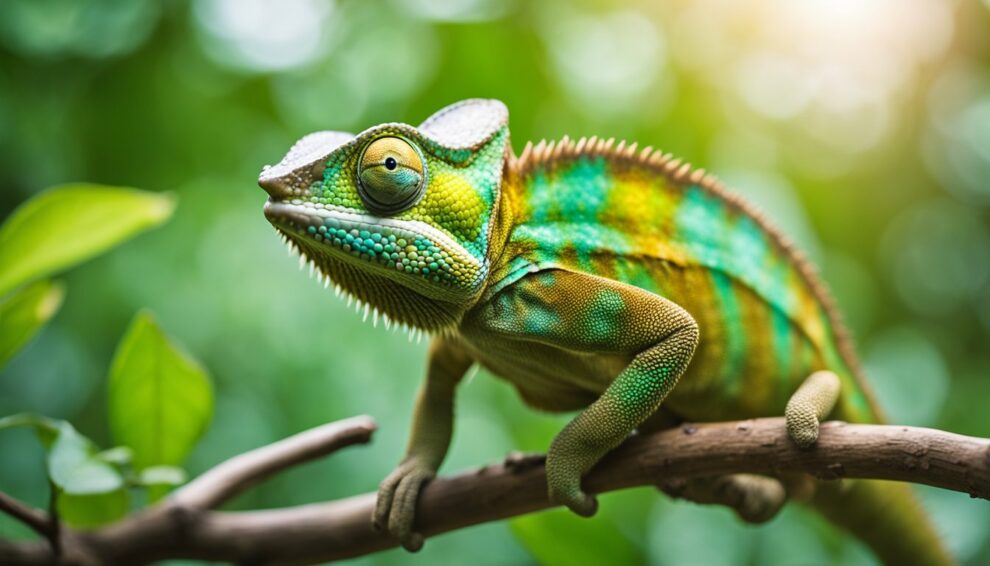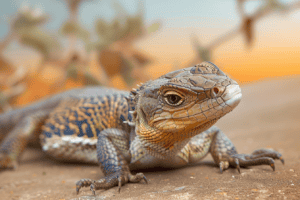Imagine a world where you could change your outfit in the blink of an eye, simply to convey a message or camouflage yourself.
Well, that’s everyday life for many reptiles! Using colors and patterns, they communicate with each other and navigate the complexities of their habitats.
Chameleons, for example, are known for their vivid color transformations, which can signal everything from a mood swing to a territorial warning.

Have you ever wondered why a lizard might suddenly go from green to brown?
It’s not just for style; these creatures are equipped with specialized cells that allow them to blend into their surroundings or stand out dramatically.
They might be trying to attract a mate or deter a potential threat.
By changing their appearance, reptiles have mastered an unspoken language that is as colorful as it is complex.
In their scaly world, the hues they brandish can mean the difference between life and death.
They carefully control this ability to regulate their body temperature, since they can’t warm up or cool down like we do.
You see, the dark colors soak up the sun on a chilly morning, and lighter colors reflect it during the scorching midday heat.
So, the next time you see a reptile changing color, remember, they’re doing a lot more than just showing off—they’re surviving, thriving and chatting in their own remarkable way.
Basics of Reptilian Chromatics
Reptiles use their colorful canvases not just for hiding but for chatting, too! It’s a silent language that’s all about hues and shades.
Why Reptiles Change Color
Have you ever wondered why chameleons or other reptiles suddenly shift from green to brown?
They’re not trying to show off – they are actually communicating!
Some lizards signal to their pals with a quick color flick or warn enemies that they’re ready to rumble.
And it’s not just about looking tough; reptiles might also change their wardrobe of colors to snag a date or to control their temperature.
Basic Mechanisms of Color Transformation
How do these cool creatures flip their pigments like a light switch? The secret lies in super special cells called chromatophores.
These cells have layers with different pigments that can spread out or bunch up.
When reptiles want to switch their look, they send a signal to the chromatophores, and voila! A different color appears.
In simple terms, imagine them as tiny balloons with colored ink that expand and shrink, changing the reptile’s color to green, red, or a sizzling yellow!
Communication Through Hues

Reptiles use colors in remarkable ways to communicate with one another.
From finding a partner to warding off threats, their vibrant hues are key to survival.
Signaling Mates and Rivals
In the quest for a mate, many reptiles boast brilliant colors to catch the eye of potential partners.
Male chameleons, for example, display dynamic color changes to impress females or intimidate rival suitors.
Bright colors signal good health and genetic fitness, giving them an edge in the mating game.
Similarly, when rival males lock eyes, their colors become even more intense.
They use this visual language to establish dominance without the need for physical confrontation.
Threat Display and Camouflage
Imagine you’re a predator, but when you’re ready to pounce, your prey changes color and blends into the background.
This is a tactic many reptiles use, like the Anolis lizard, whose ability to change from bright green to brown helps it stay hidden from both predators and prey.
In contrast, some species utilize color to make themselves look more threatening.
For instance, the frill-necked lizard expands its frill and shows bold colors to appear larger and fend off adversaries.
It’s a clever way to avoid a fight by simply putting on a show.
Engaging with these creatures visually allows us to peek into their lives and understand how vital colors are for their interactions.
Next time you’re observing these scaly friends, pay close attention to their colors; they might just be telling you something!
Variations Among Species

The ability to change color varies widely among reptile species, with some boasting a virtual rainbow of possibilities, while others display subtler shifts.
Chameleons’ Mastery of Color Shift
Chameleons are often referred to as the masters of disguise in the reptile world because of their impressive range in color-changing capabilities.
They utilize this skill for communication and temperature regulation rather than for camouflage as commonly believed.
The chameleons’ unique ability stems from the specialized cells in their skin called chromatophores, which contain different pigments.
Below the chromophores lie cells called iridophores and guanophores that reflect light, further adding to the spectrum of color possibilities.
Fun Fact: Did you know that the mood of a chameleon can be indicated by its color?
For instance, a darkening color often signifies stress, while brighter colors can signify a desire to communicate.
Other Reptiles’ Color Capabilities
While chameleons may take the spotlight, other reptile species possess their own unique color-changing attributes.
The common anole lizard, for instance, may alter its hue from brown to bright green to escape predators or impress a potential mate.
This change is primarily controlled by hormones.
Unlike chameleons, these lizards have a more limited color range, since their chromatophores contain fewer pigment options.
Did you spot that lizard? Sometimes all you’ll notice is a slight change in shade, a hint that there’s more to that little critter than meets the eye!
Curious Question: Have you ever wondered what it would be like to change colors like these incredible reptiles?
Imagine the stories they’d tell if they could share their colorful experiences!
Impact of Environment

Reptiles communicate through color changes, a process intricately linked to their environment.
The surroundings play a crucial role in how these creatures display their various hues.
Role of Light and Temperature
The sun is like a spotlight for the color-changing stage in reptiles.
Light levels determine the brightness and intensity of a reptile’s coloration.
For instance, chameleons bask in sunlight to bring out vivid colors.
They use these radiant displays to communicate with other chameleons, showing off their mood or establishing territory.
Temperature also affects their color-changing abilities.
Colder environments can cause a reptile’s color to become duller, which might signal a need to warm up.
Habitat Influence on Color Expression
Imagine reptiles as artists, and their habitat as the canvas influencing their color palette. In lush jungles, greens and browns dominate.
These shades allow reptiles to camouflage perfectly.
Conversely, in desert landscapes, reptiles display lighter colors, reflecting an adaptation to blend in with sandy and rocky habitats.
These color adaptations are not just for hiding; they also help communicate.
A reptile that matches its environment can startle a predator or rival by suddenly becoming visible, demonstrating that it owns that piece of the wild.
Frequently Asked Questions

Reptiles use a variety of fascinating methods to change their colors, serving as vital tools for communication and adaption to their environment.
This section digs into the how and why behind their color-changing abilities, providing a closer look at the incredible world of these cold-blooded communicators.
What mechanisms do chameleons utilize to alter their skin color?
Chameleons possess a unique set of skin layers containing specialized cells known as chromatophores.
The top layers, filled with different pigments, expand or contract to showcase vibrant colors or patterns.
This shifting display is made possible by the chameleon’s complex hormonal and neural controls, which respond to mood, temperature, and environmental factors.
How does the change in color facilitate communication among chameleons?
Color changes in chameleons can act as social signals, with different hues indicating a range of messages.
A chameleon might turn a bright color to show dominance or to attract a mate, while darker colors might express submission or stress.
These visual signals are crucial for their interactions, effectively ‘talking’ through their skin.
Can you explain the role of photonic crystals in reptiles’ color shifts?
Certain reptiles, like some lizards, have microscopic structures in their skin called photonic crystals.
These crystals interact with light, reflecting certain wavelengths to create stunning iridescent effects.
It’s not just for show; these shifts can communicate a lizard’s physiological state or help it blend into its surroundings.
What drives the evolution of color-changing abilities in chameleons?
The evolutionary journey has led to chameleons developing their color-changing skills as a survival asset.
By adapting to their environments, these changes aid in camouflage, thermoregulation, and social interaction—all vital for evading predators and attracting mates, ensuring the propagation of their species.
How does the presence of chromatophores affect a reptile’s ability to change its color?
Chromatophores are cells that contain pigments; they exist in multiple layers beneath a reptile’s skin.
When these cells change, they alter the skin’s coloration.
The interplay between different chromatophores and their pigments can create an impressive array of colors, enabling reptiles to respond visually to their environment and internal states.
What determines the specific colors a lizard adopts in its environment?
The specific colors a lizard might adopt are typically influenced by factors such as light, temperature, mood, and the presence of other lizards.
Environmental colors also play a role, as lizards often shift their coloration to match their surroundings—whether for hunting, hiding, or communicating with other lizards in their habitat.









